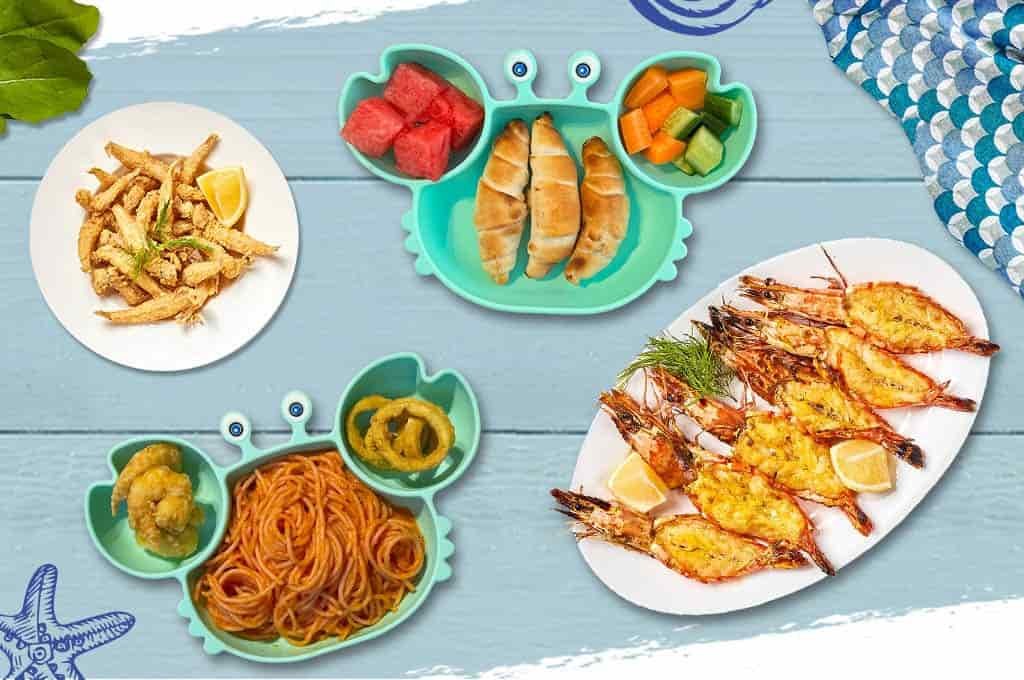Seafood is one of the most nutrient-dense food groups, yet many parents struggle to get their children to enjoy it. The challenge lies not in the nutritional value—fish like salmon, cod, and tuna are loaded with omega-3 fatty acids, vitamin D, and lean protein—but in the texture, taste, and smell that children often reject.
To make seafood a regular part of a child’s diet, parents need specific strategies: selecting safe and mild-flavored fish, cooking methods that reduce fishiness, and presentation styles that appeal to younger eaters. This article provides 15 detailed answers to common parental questions about serving seafood to kids—covering safety, allergy risks, cooking techniques, age-appropriate choices, and creative ideas for turning fish into a fun mealtime favorite.
You’ll also learn how to build seafood-based lunchboxes, identify low-mercury species, and know when it’s safe for your child to eat sushi. This guide is structured for practical use at home and optimized for search-friendly discovery, so each question leads to a precise, confident answer.
Contents
- 1 Why should children eat seafood at least once a week?
- 2 Which types of fish are safe and appropriate for young children?
- 3 At what age can children start eating seafood, and how should it be introduced?
- 4 How can parents detect and prevent seafood allergies in children?
- 5 How do you cook fish without it smelling “fishy”?
- 6 What are the easiest seafood dishes for kids to eat at dinner?
- 7 How can parents make seafood dishes look more appealing to kids?
- 8 Is it better to fry, steam, or bake fish for young children?
- 9 Can children eat sushi or sashimi, and when is it safe?
- 10 How should seafood be stored and selected for home-cooked kids’ meals?
- 11 How can parents turn seafood into school lunches or snacks for kids?
- 12 How can you encourage a child to try fish for the first time?
- 13 Should children take omega-3 supplements instead of eating fish?
- 14 Encouraging a lifelong seafood habit: where to go next
Why should children eat seafood at least once a week?
Children should eat seafood at least once a week because it supports brain development, immune function, and heart health.
The American Academy of Pediatrics recommends that children consume 1 to 2 servings (2–4 ounces) of low-mercury seafood per week starting at age 2. The omega-3 fatty acids DHA and EPA in fish like salmon and sardines directly contribute to cognitive growth and visual acuity.
A 2020 study in the American Journal of Clinical Nutrition showed that children who ate fish weekly scored 4.8% higher in cognitive tests and had reduced rates of sleep disturbances. Additionally, fish provides vitamin D—a nutrient deficient in over 61% of children globally—which improves calcium absorption and reduces bone growth issues.
Seafood also strengthens the immune system due to its high content of selenium and zinc, two trace minerals critical in white blood cell function.
Which types of fish are safe and appropriate for young children?
Safe fish for young children include low-mercury, soft-texture, mild-flavored species such as salmon, tilapia, cod, haddock, and trout.
Fish must be low in mercury because children under age 10 are 4x more vulnerable to neurotoxic damage from mercury exposure. The U.S. FDA’s “Best Choices” list includes:
- Salmon – High in omega-3s, soft texture
- Tilapia – Neutral flavor, inexpensive, easy to digest
- Haddock – Flaky white fish, ideal for baking or broiling
- Catfish – Mild taste, easy to cook, widely available
- Cod – Slightly firmer but safe if cooked until tender
Avoid fish such as king mackerel, shark, swordfish, and tilefish due to high mercury levels. Tuna should be limited to canned light tuna (no more than 1 serving per week) for kids under 6.
At what age can children start eating seafood, and how should it be introduced?
Children can begin eating seafood at 6 months of age if the fish is fully cooked, deboned, and served in age-appropriate portions.
According to guidelines by the National Institute of Allergy and Infectious Diseases, early introduction of allergenic foods like fish may actually reduce the risk of developing food allergies. Fish should be introduced one species at a time, waiting 3–5 days between new introductions to monitor for any reaction.
To reduce choking risks, fish should be mashed or pureed for infants aged 6–9 months, then gradually transitioned to small flakes by 10–12 months. For toddlers, baking or steaming is preferred over frying, and bones must be completely removed.
Do not introduce raw or undercooked seafood before the age of 5, as children’s immune and digestive systems are not yet fully developed to handle potential pathogens.
How can parents detect and prevent seafood allergies in children?
Parents can detect seafood allergies in children by monitoring for specific symptoms within 2 hours of consumption and can prevent them through gradual, single-species introduction.
There are two main types of seafood allergies:
- Fish allergy – commonly caused by species like cod, tuna, or salmon
- Shellfish allergy – triggered by crustaceans (e.g., shrimp, crab) and mollusks (e.g., clams, oysters)
6 common early symptoms include:
- Itchy mouth or throat
- Facial swelling
- Hives or skin rash
- Vomiting or diarrhea
- Coughing or wheezing
- Dizziness or fainting
Severe cases may result in anaphylaxis, which occurs in approximately 2% of children with seafood allergies, according to the American College of Allergy, Asthma & Immunology.
To prevent allergic reactions:
- Introduce only one new seafood item at a time
- Start with cooked white fish like cod or haddock
- Avoid shellfish during the first year
- Have antihistamines available at the first trial, especially if there’s a family history of food allergies
- Consult an allergist for an IgE-specific blood test before introducing high-risk items
How do you cook fish without it smelling “fishy”?
To cook fish without a strong smell, use acid-based marinades, dry-heat methods like baking, and extremely fresh fish.
4 proven techniques reduce fish odor effectively:
- Soak in lemon juice or vinegar for 15 minutes before cooking. Acid denatures trimethylamine—the compound responsible for fishy odor.
- Cook using dry heat methods like roasting, baking, or grilling instead of steaming or boiling. These limit vaporized amines.
- Use herbs like dill, parsley, or ginger to mask remaining odors.
- Buy fish the same day you cook it. The longer fish is stored—even refrigerated—the more trimethylamine builds up.
Fish that naturally produce less odor include tilapia, flounder, and cod. Oily fish such as mackerel and sardines have higher amine levels and should be avoided for odor-sensitive households.
What are the easiest seafood dishes for kids to eat at dinner?
The easiest seafood dishes for kids are soft, bite-sized meals such as homemade fish sticks, salmon patties, and cheesy tuna bake.
Children prefer dishes that are:
- Mild in flavor
- Soft in texture
- Familiar in form (e.g., finger foods or patties)
3 easy dinner options for seafood beginners:
- Homemade fish sticks – Made with cod or tilapia, coated in breadcrumbs, oven-baked
- Salmon patties – Mixed with mashed potato and egg, pan-fried for crispness
- Cheesy tuna pasta bake – Uses canned light tuna, macaroni, and a light cheese sauce
These meals combine protein with familiar ingredients like pasta or potatoes, increasing acceptance. Adding vegetables like peas or carrots can boost nutrition without altering flavor drastically.
How can parents make seafood dishes look more appealing to kids?
Parents can make seafood dishes more appealing to kids by using playful presentation, colorful ingredients, and interactive plating techniques.
Children are visual eaters. Research published in Appetite Journal found that plate color and food arrangement increased acceptance by 23% among children aged 3–8.
3 effective strategies to improve visual appeal:
- Shape-based presentation – Use cookie cutters to form fish patties into stars, animals, or hearts
- Color contrast – Combine fish with bright vegetables like carrots, peas, and red bell peppers
- Interactive plates – Serve ingredients separately (deconstructed meal) to allow kids to assemble their own bites
Tools that support creative plating include bento boxes, vegetable stampers, and food-safe drawing pens (e.g., seaweed wrappers cut into faces). Serving fish in tacos or mini skewers also mimics snack-style eating, increasing child engagement.
Is it better to fry, steam, or bake fish for young children?
Baking is the healthiest and most practical method to prepare fish for young children, followed by steaming and then shallow frying.
Comparison of cooking methods based on 4 factors:
| Method | Nutrition Retention | Texture | Oil Use | Child Safety |
|---|---|---|---|---|
| Baking | High | Flaky | Minimal | Very Safe |
| Steaming | High | Moist | None | Safe |
| Frying | Low | Crispy | High | Less Safe |
- Baking at 375°F (190°C) for 15–20 minutes retains omega-3 fatty acids while achieving a mild, flaky texture.
- Steaming works best for very young children who need softer foods.
- Frying, especially deep frying, introduces unnecessary saturated fat and increases acrylamide exposure—a chemical linked to digestive inflammation in young children.
To keep meals healthy and engaging, bake fish with whole grain breadcrumbs or a cheese crust and serve with dipping sauces like yogurt-based dill or lemon aioli.
Can children eat sushi or sashimi, and when is it safe?
Children should not eat raw seafood like sushi or sashimi before age 5 due to infection risks; after that, only low-risk species should be used.
Raw fish can carry parasites such as Anisakis simplex or Tapeworms, which cause abdominal pain, vomiting, and allergic reactions. The CDC advises against raw seafood for young children whose immune systems and digestive enzymes are underdeveloped.
Age-based guidelines:
- 0–5 years: Only fully cooked fish, no sushi or sashimi
- 6–12 years: Cooked sushi rolls (e.g., tempura shrimp, imitation crab, avocado)
- 12+ years: Raw sushi only if prepared using sashimi-grade fish and consumed fresh from a trusted source
Parents must ensure the sushi is prepared following FDA-approved freezing protocols (e.g., -4°F for 7 days) to eliminate parasites. For safe options, refer to our full guide: What Does Sushi-Grade Mean?
How should seafood be stored and selected for home-cooked kids’ meals?
Seafood should be selected based on freshness indicators and stored under 40°F (4°C) to ensure safety and nutrient retention.
To reduce the risk of foodborne illness, parents must follow USDA seafood safety guidelines when buying and storing fish for children.
5 freshness indicators when selecting fish:
- Clear, bulging eyes
- Firm, elastic flesh
- Shiny, metallic skin
- No fishy odor—smell should resemble the ocean
- Cold to the touch (not slimy or sticky)
Storage methods:
- Refrigeration: Store fresh fish in the coldest section, ideally on ice, for no more than 2 days
- Freezing: Wrap tightly in vacuum-sealed bags and store at 0°F (-18°C) for up to 3 months
- Thawing: Use only refrigerator thawing (never room temperature) to prevent bacterial growth
Avoid buying pre-marinated or heavily processed seafood products for children, as these often contain excess sodium and artificial preservatives.
How can parents turn seafood into school lunches or snacks for kids?
Parents can create seafood-based lunches or snacks using finger-friendly formats like tuna wraps, salmon rice balls, and mini crab cakes.
3 practical seafood lunchbox ideas:
- Tuna pinwheels – Whole wheat tortilla spread with light mayo and canned light tuna, rolled and sliced into bite-sized rounds
- Salmon onigiri (rice balls) – Seasoned salmon flakes wrapped in rice and shaped with molds
- Mini crab cakes – Oven-baked with lump crab, breadcrumbs, and sweet corn, sized for lunchbox portions
For snacks, include options like:
- Crispy baked fish sticks with yogurt dip
- Low-sodium fish jerky
- Tuna salad on whole-grain crackers
Use bento box compartments to separate flavors, keep textures fresh, and make presentation more fun.
How can you encourage a child to try fish for the first time?
To encourage a child to try fish for the first time, serve it in a familiar format, use positive role modeling, and avoid pressure-based feeding.
Children are 68% more likely to accept new foods if they see a trusted adult enjoying it with enthusiasm, according to a 2022 Pediatric Nutrition Review.
4 proven encouragement strategies:
- Start with mild-tasting fish like cod or tilapia
- Incorporate it into familiar dishes – such as fish tacos, pasta, or cheesy bakes
- Avoid forcing – Instead, use the “no thank you bite” method (try one bite, no pressure to finish)
- Involve the child in cooking – Kids who help prepare meals are more willing to taste what they’ve made
Gradual exposure works better than one-time persuasion. Offer the same seafood 3–5 times over two weeks, in varied forms and presentations.
Should children take omega-3 supplements instead of eating fish?
Children should only take omega-3 supplements when they are allergic to fish or unable to consume sufficient seafood through diet.
Whole seafood provides more than just omega-3 fats. It contains complete proteins, selenium, vitamin B12, iodine, and other micronutrients that supplements lack. According to the Harvard T.H. Chan School of Public Health, food-based omega-3s are 25% more bioavailable than synthetic or encapsulated forms.
Supplementation is appropriate in two cases:
- Confirmed seafood allergy – Use purified fish oil supplements certified by third-party testers (e.g., IFOS)
- Extremely selective eating behavior – When fish intake is consistently below one 2–4 oz serving per week for more than 2 months
When choosing supplements, select products that contain DHA (docosahexaenoic acid) in doses of 150–250mg/day for children aged 4–12. Avoid cod liver oil, which may contain excessive vitamin A.
Encouraging a lifelong seafood habit: where to go next
Once seafood becomes a part of your child’s regular meals, you can deepen their exposure through global dishes, seasonal choices, and even kid-safe raw preparations under supervision. Developing this habit opens doors to a wide variety of lean protein sources and introduces children to diverse food cultures.
To expand this journey:
- Learn how to pick the right fish safely at the market in our article: How to Choose Sashimi-Grade Seafood Safely at Home
- Understand species safety and classifications via: What Does Sushi-Grade Mean? Understanding Raw Fish Safety and Quality Standards
- Stay alert to food reactions with: Common Seafood Allergies: What You Need to Know
The earlier you normalize seafood in your child’s routine, the easier it becomes to explore flavor complexity, nutritional depth, and even sustainability awareness through food. Fish doesn’t need to be fancy—just fun, safe, and familiar.



